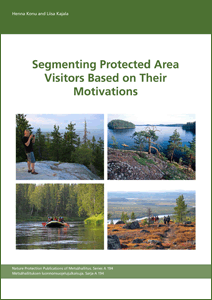Segmenting protected area visitors based on their motivations
National parks and other protected areas are popular destinations for people who want to take part in the activities of nature-based leisure, travel and ecotourism. It is essential to understand the nature of park visitors in order to be able to: minimize the impact of increasing visitation to protected areas on park resources; develop effective education programs and public relations; have effective risk management in the protected areas; and create an efficient marketing strategy for the areas. The general aim is to provide a good quality travel experience for visitors in a way that does not harm the natural resources that attract the visitors to the areas in first place.
The main aim of the study is to segment Finnish protected area visitors based on leisure motivation factors so that the services and marketing communications of the protected areas can be better targeted to diverse customer groups. Hence, the main research question is: What kinds of motivation-based visitor segments are there in Finnish protected and recreational areas?
The data were collected in Finnish national parks and protected areas administrated by Metsähallitus using standardized methods and a standard questionnaire. The target group was national and international visitors to the state-owned Finnish protected and recreational areas. In protected areas, the questionnaire was given to respondents who filled it out themselves. In total, 34,868 responses were collected during the years 2000–2010. This data include material from 91 different visitor surveys and from 74 different nature areas. Customer segments were formed by using cluster and discriminant analyses.
Four motivation-based segments that differed significantly from each other were identified: Social self-developers; Exercising nature explorers; Nostalgia appreciative seekers of mental well-being; and Nature-oriented relaxation seekers. The motivation factors that had the most discriminating power between all segments were pleasant old memories, experiencing excitement and meeting new people.
Statistically significant differences were identified between the segments concerning diverse areas. Members of the segment Nostalgia appreciative seekers of mental well-being visited the most national parks compared to other segments, while Nature-oriented relaxation seekers and Exercising nature explorers are the biggest groups who visit nature reserves. Social self-developers visited the most hiking and other areas such as wilderness areas and cultural places. There were also significant alterations in shares of segments during the period 2000–2010. Discussions on the implications of the results for practice, future research and challenges faced conclude the study.
